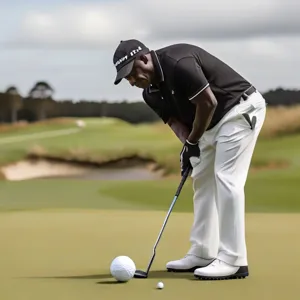Golf, often considered a game of precision and strategy, is heavily influenced by the choice of clubs in your bag.
Among these, the driver and wood are two essential tools, each playing a pivotal role in your overall performance on the course. While both clubs are designed to achieve distance and accuracy, they possess distinct characteristics that cater to different aspects of your game. Understanding the key differences between a driver and a wood can significantly enhance your golfing experience, helping you make smarter decisions on the tee and fairway. In this post, we’ll delve into the unique features, ideal usage scenarios, and performance outcomes of these clubs, unlocking insights that will empower you to elevate your game and navigate the course with confidence. Whether you’re a seasoned golfer looking to refine your skills or a newcomer eager to understand the fundamentals, this comprehensive guide will equip you with the knowledge needed to optimize your performance and enjoy every swing.
1. Introduction to Golf Clubs: Understanding the Basics

Golf clubs are the essential tools that every golfer relies on to navigate the course, and understanding their various types is crucial for enhancing your performance and enjoyment of the game. At the heart of this discussion are two of the most fundamental club categories: drivers and woods.
A golf club is composed of three main parts: the grip, the shaft, and the clubhead. Each of these elements plays a vital role in how a club feels and performs during a swing. The grip is where you hold the club, influencing your control and comfort. The shaft connects the grip to the clubhead and varies in length and flexibility, impacting your swing speed and trajectory. Finally, the clubhead is the business end of the club, designed to strike the ball and send it soaring toward the target.
Drivers, often referred to as the longest clubs in a golfer’s bag, are specifically engineered for distance. With their oversized heads and low loft angles, they are perfect for tee shots, allowing players to maximize their power and achieve impressive yardage. On the other hand, woods—typically numbered 1 to 7—are versatile clubs primarily used for longer fairway shots. While they share a similar design with drivers, woods have higher lofts, making them ideal for launching the ball into the air and navigating challenging terrain.
In this blog post, we will dive deeper into the specific characteristics of drivers and woods, exploring how each can be leveraged to improve your game. By understanding the unique advantages and best uses for these clubs, you’ll be better equipped to make informed decisions on the course, ultimately leading to enhanced golfing performance and enjoyment. Let’s take a closer look at what sets these clubs apart and how to choose the right one for your style of play.
2. What is a Driver? Purpose and Specifications
When it comes to the game of golf, the driver stands out as one of the most iconic clubs in any golfer’s bag. Designed specifically for distance, the driver is typically the longest club, boasting a large head and a low loft angle, usually between 8 to 12 degrees. This unique design allows golfers to achieve maximum velocity on their swings, translating into impressive distances off the tee.
The primary purpose of a driver is to launch the ball as far as possible down the fairway, ideally setting up a favorable approach shot to the green. With its oversized clubhead—often exceeding 460cc—modern drivers provide a larger sweet spot, making it easier for golfers to achieve optimal contact, even on less-than-perfect swings. The face of the driver is typically constructed from lightweight materials like titanium or composite materials, which helps to enhance both strength and performance while reducing overall weight.
Another key specification to consider is the shaft length, which usually ranges from 44 to 48 inches. This length is critical as it influences swing speed; a longer shaft can lead to greater distance but may sacrifice control if not handled properly. Furthermore, the driver’s grip is designed for comfort and control, allowing golfers to maintain a solid hold through the swing.
In the world of golf, the driver is not just a club; it embodies the power and potential of the game. Mastering the use of a driver can significantly improve a player’s performance, making it essential for golfers to understand its purpose and specifications. Whether you are a seasoned player or just starting out, investing time in learning how to effectively use your driver can be a game-changer on the course.
3. What is a Wood? Purpose and Specifications

### What is a Wood? Purpose and Specifications
When it comes to golf clubs, “woods” hold a distinct place in the heart of the game, both in terms of their historical significance and their functionality on the course. Traditionally crafted from wood—hence the name—these clubs have evolved into highly engineered tools designed for maximum distance and precision. Today, woods are typically constructed from advanced materials like titanium or composite materials, offering golfers a perfect blend of power and control.
The primary purpose of a wood is to hit the ball over longer distances, particularly from the tee or the fairway. Woods are characterized by their larger clubheads and longer shafts, which allow for a more sweeping swing that generates greater speed and, consequently, more distance. The most common types of woods are the driver (often referred to as the 1-wood) and fairway woods, which include the 3-wood and 5-wood. Each type serves a specific function: the driver is designed for maximum distance off the tee, while fairway woods are ideal for longer shots from the fairway or rough.
In terms of specifications, woods typically feature a lower loft compared to irons, which helps players achieve a higher trajectory and longer roll. For instance, a driver will usually have a loft between 8 and 12 degrees, while a 3-wood might range from 15 to 18 degrees. The clubhead size also plays a crucial role; modern drivers can have heads exceeding 460cc, designed for an expanded sweet spot that increases forgiveness on off-center hits.
Another important aspect of woods is their shaft length. Drivers generally have the longest shafts, averaging around 45 inches, while fairway woods feature slightly shorter shafts for increased control and accuracy. Understanding these specifications can help golfers choose the right wood for their swing style and playing conditions, ultimately leading to better performance on the course.
In essence, woods are not just about hitting the ball far; they embody the balance between power and precision, making them essential tools in any golfer’s bag. By grasping their purpose and technical specifications, players can make informed decisions that enhance their overall game.
4. Key Differences in Design: Driver vs. Wood
When it comes to golf clubs, the design nuances between drivers and woods are pivotal in understanding how each can affect your performance on the course. While both types of clubs fall under the category of ‘woods,’ they serve distinct purposes and are crafted with unique features that cater to different aspects of the game.
**Clubhead Size and Shape**
The driver, designed specifically for maximizing distance off the tee, boasts the largest clubhead of any golf club, typically around 460cc. This larger head not only helps in achieving higher launch angles but also creates a larger sweet spot, making it more forgiving on off-center hits. In contrast, fairway woods, while still larger than traditional irons, have smaller clubheads that are more streamlined and aerodynamic. This design enables better maneuverability and precision for shots taken from the fairway or rough, allowing golfers to strike the ball cleanly and with greater control.
**Loft Angles**
Another significant difference lies in the loft angles. Drivers usually have a lower loft, generally ranging from 8 to 12 degrees, which is optimal for achieving that long, soaring flight on the tee. Fairway woods, on the other hand, come with higher lofts—typically between 15 to 25 degrees—making them ideal for hitting the ball from the ground. The increased loft allows players to get the ball airborne more easily, providing a more forgiving option when facing challenging lies.
**Shaft Length and Flexibility**
Drivers also feature longer shafts compared to woods, which contributes to the potential for greater distance. The standard driver shaft length hovers around 45 inches, while fairway woods are generally shorter, ranging from 40 to 42 inches. This length difference affects swing dynamics; the longer shaft of the driver can generate more clubhead speed, but it requires precise timing and control. In contrast, the shorter shaft of a wood enhances stability and accuracy, making it a more user-friendly choice for various swing types.
**Weight Distribution and Center of Gravity**
Lastly, the weight distribution and center of gravity (CG) are tailored differently in drivers and woods. Drivers often have a lower and deeper CG, which helps in achieving that high launch and low spin necessary for maximizing distance. Fairway woods, however, are designed with a CG that promotes easier launch angles and improved turf interaction, making them more effective for hitting from different lies.
Understanding these key differences in design can significantly enhance your golfing performance. Whether you’re teeing off with a driver or navigating the fairway with a wood, knowing how each club is engineered to function will empower you to make more informed choices and improve your overall game.
5. Loft and Launch Angle: How They Affect Your Game

When it comes to improving your golfing performance, understanding the concepts of loft and launch angle is crucial. These two factors play a significant role in determining how your ball travels through the air, impacting distance, accuracy, and overall playability on the course.
**Loft** refers to the angle of the clubface relative to the ground. Different clubs have varying lofts, with drivers typically featuring a lower loft ranging from 8 to 12 degrees, while woods and hybrids often have higher lofts, usually between 15 to 25 degrees. This difference in loft affects how high the ball will launch from the clubface. A lower loft, like that of a driver, produces a flatter trajectory, allowing the ball to cover more distance. In contrast, a higher loft generates a steeper angle of ascent, which can help with stopping power on the greens or navigating obstacles like trees.
**Launch angle**, on the other hand, is the angle at which the ball leaves the clubface, influenced by both the loft of the club and the swing dynamics of the golfer. A proper launch angle is essential for maximizing distance; too low of a launch can cause the ball to lose momentum and drop quickly, while too high of a launch can lead to a loss of distance due to increased drag from the air. Ideally, drivers benefit from a launch angle around 12 to 15 degrees for optimal distance, whereas woods can vary depending on their design and the golfer’s swing mechanics.
For golfers seeking to enhance their game, it’s beneficial to experiment with different lofts and launch angles during practice sessions. A professional fitting session can also provide personalized insights, ensuring that your equipment aligns with your swing characteristics. Understanding these two critical elements will empower you to choose the right clubs and make informed adjustments to your swing, ultimately leading to improved performance on the course. So whether you’re teeing off with a driver or navigating tricky lies with a wood, being mindful of loft and launch angle can make all the difference in your game.
6. Distance vs. Accuracy: Understanding the Trade-offs
When it comes to golf, the age-old debate between distance and accuracy can significantly influence your performance on the course. Understanding the trade-offs between using a driver and a wood is essential for any golfer looking to refine their game.
Drivers are designed for maximum distance, boasting a larger clubhead and a longer shaft that allows players to unleash explosive power off the tee. The thrill of launching the ball down the fairway with impressive speed is undeniably appealing, especially when that perfect sweet spot is hit. However, this pursuit of distance often comes at a cost: accuracy. The larger clubhead can lead to a more forgiving miss, but the longer shaft can make it more challenging to control your swing. As a result, many golfers find themselves sacrificing precision in order to gain those extra yards.
On the other hand, fairway woods offer a remarkable balance between distance and control. With a shorter shaft and a more compact clubhead, woods are easier to handle, allowing for greater accuracy on approach shots and from the fairway. While they may not be able to achieve the same extreme distances as a driver, they are ideal for navigating tricky lies or tight fairways, where precision is crucial. Many golfers find that using a wood can help them maintain better control over their shots, making it easier to land the ball on the green.
Ultimately, the choice between distance and accuracy depends on your individual playing style and the specific challenges of the course you’re tackling. If you’re a player who thrives on the thrill of a long drive but struggles with consistency, you might want to consider incorporating more woods into your game. Conversely, if you prioritize hitting fairways and greens over sheer distance, focusing on your wood game can lead to lower scores and a more enjoyable round. By understanding these trade-offs and experimenting with both club types, you can unlock the potential for better golfing performance and find the right balance that suits your unique style.
7. Swing Mechanics: Adjusting Your Technique for Each Club

When it comes to mastering the art of golf, understanding swing mechanics is crucial, especially when transitioning between a driver and a wood. Each club demands a unique approach, and adjusting your technique can significantly enhance your performance on the course.
The driver, with its long shaft and large clubhead, is designed for maximum distance. To optimize your swing with a driver, you should adopt a sweeping motion. This means positioning the ball forward in your stance, allowing the club to strike the ball on the upswing. Focus on a smooth, controlled motion that harnesses your body’s rotation rather than just your arms. This will help you achieve a powerful launch angle, sending the ball soaring down the fairway.
In contrast, when using a wood, particularly from the fairway or rough, your approach should be more precise. Woods are typically shorter than drivers and have a flatter face, which requires a different swing dynamic. Position the ball slightly back in your stance compared to the driver, and focus on making solid contact with the ball. Imagine hitting through the ball rather than sweeping it, as this will help to ensure a clean strike and optimal trajectory.
Practicing the specific swing mechanics for each club will not only improve your consistency but also boost your confidence as you navigate different situations on the course. By tailoring your technique to suit the unique characteristics of your driver and woods, you can fine-tune your game and elevate your overall golfing performance. Take the time to experiment with your stance, grip, and swing path with each club, and soon you’ll find yourself making more accurate and powerful shots, bringing you closer to mastering the game.
8. Situational Use: When to Choose a Driver Over a Wood
Understanding when to choose a driver over a wood can significantly enhance your golfing performance. Each club serves a unique purpose, and situational awareness on the course is key to making the right choice.
The driver, often characterized by its larger clubhead and longer shaft, is designed for maximizing distance off the tee. Its low loft allows for a powerful, sweeping motion that can launch the ball high and far, making it the go-to club for long par 4s and par 5s. If you find yourself on a wide-open hole with ample space to swing and a need for maximum distance, reaching for your driver is the obvious choice. The thrill of watching your ball soar down the fairway is unmatched, especially when the conditions are favorable, such as with a slight tailwind or firm ground that allows for extra roll.
Conversely, woods—particularly the 3-wood and 5-wood—are versatile clubs that come into play in a variety of situations, both off the tee and from the fairway. With a slightly higher loft and shorter shaft compared to the driver, woods provide more control and accuracy, making them ideal for tight lies or situations where precision is paramount. For instance, if you’re facing a narrow fairway flanked by trees or hazards, the wood can help you navigate the course with greater accuracy while still offering impressive distance. Additionally, when you’re attempting to reach the green in two on a long par 5, a wood can often deliver the right balance of distance and control needed for a successful approach.
Ultimately, the decision should also take into account your personal comfort level with each club. If you’re confident in your ability to handle the driver’s power and length, that might be your first choice. However, if you find yourself struggling with consistency, opting for a wood could be a wise strategy to keep your game on track. By mastering the art of situational use between drivers and woods, you can elevate your golfing performance and navigate the course with greater finesse.
9. Common Mistakes: Misusing Drivers and Woods
When it comes to maximizing your performance on the golf course, understanding the common mistakes associated with misusing drivers and woods can make a significant difference in your game. Both clubs serve distinct purposes, yet many golfers struggle to grasp their unique functionalities, leading to frustrating and inconsistent results.
One of the most prevalent mistakes is using a driver in situations where a wood would be more appropriate. The driver, designed for maximum distance off the tee, is not always the best choice for every shot. For instance, trying to use a driver for a long fairway shot can lead to mishits, as the club’s low loft and longer shaft make it difficult to control. Instead, opting for a fairway wood can provide better accuracy and a higher launch angle, allowing for a more manageable approach to the green.
Conversely, some golfers underestimate the power of their woods. The misconception that woods are only for long-distance shots can lead to missed opportunities for using them effectively from the fairway or even the rough. Many players shy away from using their woods when they are in prime positions to capitalize on the club’s design, which is intended to help golfers achieve great distance with a more forgiving face.
Another common mistake is poor swing mechanics when using drivers and woods. Golfers often try to swing harder with the driver, believing that more force equals more distance. However, this can lead to a loss of balance and accuracy. Instead, focusing on a smooth, controlled swing can yield better results. Similarly, with woods, many players are too quick to make adjustments to their stance or grip, leading to inconsistent contact with the ball.
Lastly, golfers sometimes fail to consider the terrain and conditions of the course. Hitting a driver off the tee on a narrow fairway lined with trees isn’t always the best strategy. Understanding when to use a wood for better maneuverability can save strokes and boost confidence.
By recognizing and addressing these common mistakes, golfers can enhance their performance and enjoy the game even more. Whether you’re teeing off with a driver or navigating the fairway with a wood, understanding the specific roles of each club will ultimately lead to a more successful and enjoyable round of golf.
10. Tips for Maximizing Performance with Each Club
To truly elevate your performance on the golf course, understanding how to maximize the potential of each club in your bag is essential. Every club has its unique characteristics, designed to help you tackle various situations with precision and skill. Here are some tips to get the most out of your driver and wood, ensuring you’re well-equipped for success on the green.
**1. Perfect Your Grip:**
The foundation of any successful shot begins with a proper grip. For both the driver and wood, ensure your grip is firm yet relaxed. A grip that’s too tight can hinder your swing, while a loose grip may lead to inconsistency. Experiment with different grip styles to find what feels best for you—this will help you maintain control and increase accuracy.
**2. Focus on Your Stance:**
Your stance plays a crucial role in your swing. When using a driver, position the ball just inside your front foot. This promotes an upward angle of attack, maximizing distance. For woods, place the ball in the center of your stance to encourage a more level swing path. Adjusting your stance based on the club will help you achieve better contact and improve your shot trajectory.
**3. Master the Swing Technique:**
The swing mechanics can vary significantly between a driver and a wood. With a driver, it’s all about generating speed and power; emphasize a full shoulder turn and a smooth transition through the swing. For woods, focus on a sweeping motion that allows for solid contact with the ball; think of it as brushing the grass rather than hitting down on it. Practicing these techniques will enhance your overall performance.
**4. Use the Course to Your Advantage:**
Understanding the course layout can dramatically influence your club selection and shot strategy. Analyze the distance, hazards, and wind conditions before each hole. For longer distances with fewer obstacles, a driver might be your best bet; however, when faced with tight fairways, a wood can provide more control while still delivering impressive distance.
**5. regular Practice:**
Like any sport, repetition is key to improvement. Regularly practicing with both your driver and woods will help you become more familiar with their characteristics and how they perform in different scenarios. Spend time at the driving range hitting a variety of shots, focusing on your accuracy, distance, and consistency.
By integrating these tips into your practice routine, you can unlock the full potential of your clubs and elevate your golfing performance. Remember, the key lies in understanding the unique attributes of each club and how to adapt your technique accordingly. With dedication and the right approach, you’ll find yourself navigating the course with confidence and skill, making every swing count.
11. The Importance of Club Fitting: Finding Your Perfect Match
When it comes to achieving optimal performance on the golf course, the significance of club fitting cannot be overstated. Imagine stepping up to the tee with a driver that feels perfectly balanced in your hands, its shaft tailored to your swing speed and your height, and the grip cushioned just right for your palm. This is the essence of club fitting—a personalized experience that transforms a standard golf club into an extension of your body.
A well-fitted club ensures that each swing is executed with precision, translating into better ball striking and greater distance. Poorly fitted clubs, on the other hand, can lead to inconsistent shots, frustration, and even injury. Whether you are a seasoned pro or a weekend warrior, the right fit can make all the difference in your game.
During the fitting process, various factors come into play: the length of the club, the flex of the shaft, the lie angle, and the type of grip. These adjustments can dramatically affect how the club interacts with the ball at impact, influencing everything from trajectory to accuracy. For instance, a golfer with a faster swing speed may benefit from a stiffer shaft, while someone with a slower tempo might find more control with a more flexible option.
But the benefits of club fitting extend beyond just performance metrics. It also enhances the overall enjoyment of the game. When you know your clubs are suited to you, confidence grows, and the mental aspect of golf becomes less daunting. You can focus more on strategy and technique rather than worrying about whether your equipment is holding you back.
In summary, investing in a proper club fitting is not just a luxury; it’s a strategic move that can elevate your golfing experience. By finding your perfect match, you not only optimize your performance but also cultivate a deeper connection with the game. So, before you head out for your next round, consider visiting a professional fitter—your golf game will thank you!
12. Mental Game: How Club Choice Affects Your Mindset
When it comes to golf, the mental game is just as crucial as physical skill, and your choice of club can greatly influence your mindset on the course. Understanding how the driver and wood differ in both function and psychological impact can be the key to unlocking your full potential as a golfer.
The driver, with its large head and longer shaft, often symbolizes power and distance. Hitting with a driver can invoke feelings of confidence and excitement, as players envision launching the ball down the fairway with impressive speed. However, this can also lead to pressure; the expectation to achieve long drives can create anxiety, especially if the last few swings didn’t go as planned. This psychological burden can manifest as hesitation or over-analysis right before a swing, leading to suboptimal performance.
On the other hand, the wood—particularly fairway woods—offers a different mental experience. With its shorter shaft and smaller head, it can promote a sense of control and precision. Many golfers find that using a wood allows them to focus on technique and strategy rather than sheer distance. The mental approach shifts from a focus on power to one of finesse, encouraging a more relaxed and measured swing. This can be particularly beneficial when navigating tricky lies or when you need to place the ball accurately on the green.
Moreover, your comfort level with each club plays a significant role in how you approach your shot. If you feel more at ease with a certain club, it can influence your confidence levels and overall mood on the course. Familiarity breeds comfort, which in turn fosters a more positive and aggressive mindset.
Ultimately, understanding how your club choice impacts your mental game can help you strategize more effectively on the course. Whether you opt for the driver or the wood, recognizing the psychological nuances of each can empower you to make better decisions, stay calm under pressure, and enhance your overall golfing performance. By aligning your mental state with your club choice, you’ll not only improve your game but also enjoy the entire golfing experience much more.
13. Expert Opinions: Insights from Professional Golfers
When it comes to understanding the nuances between drivers and woods, there’s no better source of insight than professional golfers themselves. These athletes have spent countless hours on the course, honing their skills and perfecting their swings, making their perspectives invaluable for golfers at all levels.
Many professionals emphasize the importance of choosing the right club for specific situations on the course. For instance, renowned golfer Rory McIlroy often discusses how he relies on his driver for distance off the tee but opts for a fairway wood when he needs precision on longer par 4s and 5s. He highlights that while the driver is great for maximum distance, the wood can provide better control and a higher trajectory, especially when navigating tricky lies or when playing from the fairway.
Another insight from golfing legend Phil Mickelson revolves around versatility. He points out that modern woods are engineered to be more forgiving, with larger sweet spots that allow for better mishits compared to the traditional driver. This gives players the confidence to use woods in a variety of situations, whether they’re aiming for a long carry or trying to maintain accuracy on a dogleg hole.
Moreover, many pros stress the importance of personal comfort and feel. They recommend spending time at the driving range experimenting with different brands and models to find a driver or wood that feels right. The feedback from your hands can significantly impact your performance, and as professional golfer Justin Thomas puts it, “If you trust your club, you’re halfway to a great shot.”
Incorporating these expert insights can help you make more informed decisions about which clubs to use and when, ultimately enhancing your golfing performance. Whether you’re looking to gain yards off the tee with a robust driver or navigate the course with precision using a wood, these professional perspectives can guide you toward a more successful game.
14. Conclusion: Choosing the Right Club for Your Game
In the world of golf, the choice between a driver and a wood is more than just a matter of preference; it can significantly impact your performance on the course. As we’ve explored throughout this post, each club serves a distinct purpose and offers unique advantages that cater to different playing styles, skill levels, and course conditions.
The driver, with its larger clubhead and longer shaft, is designed for maximum distance off the tee. Its low center of gravity and high loft make it ideal for launching the ball into the air, allowing for long, sweeping drives that can cover impressive distances. However, this power comes with a learning curve. A driver requires precise swing mechanics and a stable stance to harness its potential fully. If you’re a player who thrives on hitting those long tee shots, investing time in mastering this club may be your best bet.
On the other hand, woods—particularly the fairway woods—offer versatility and control. With a slightly smaller clubhead than the driver and a shorter shaft, they allow for greater accuracy and are particularly beneficial for navigating tricky lies or reaching greens from a distance. Woods are often easier to handle for players who may struggle with the longer shaft and larger head of a driver, making them a valuable addition to your bag, especially in situations where precision is key.
Ultimately, the right choice depends on your playing style, your comfort level with each club, and the specific challenges of the course you’re tackling. Whether you lean towards the explosive power of a driver or the refined control of a wood, understanding the strengths and weaknesses of each club will empower you to make informed decisions on the course. As you refine your skills and gain experience, don’t hesitate to experiment with both options to find the perfect balance for your game. Remember, the ultimate goal is not just to hit the ball further or straighter, but to enjoy the game and improve with every swing. So, embrace your journey, choose wisely, and watch as your performance flourishes on the fairways.
15. Additional Resources: Tools and Tips for Golf Improvement
When it comes to improving your golf game, having the right resources at your disposal can be a game-changer. Whether you’re a novice seeking to understand the basics or an experienced golfer looking to refine your skills, leveraging additional tools and tips can significantly enhance your performance on the course.
**Online Tutorials and Courses:** A wealth of knowledge is just a click away. Websites like YouTube host countless instructional videos from professional golfers and coaches, covering everything from swing mechanics to putting techniques. Consider enrolling in online golf courses that offer structured lessons tailored to your skill level, providing you with step-by-step guidance.
**Golf Simulators:** If you’re serious about improvement, investing in a golf simulator can be a fantastic addition to your practice routine. These high-tech devices allow you to analyze your swings in real-time, offering insights into your speed, angles, and trajectory. Many simulators also come equipped with various courses, giving you the chance to play in a virtual environment while honing your skills.
**Fitness Apps and Gear:** Golf is as much about fitness as it is about technique. Utilize fitness apps that focus on strength, flexibility, and endurance tailored to golfers. Additionally, consider incorporating specific workout gear, such as resistance bands or balance boards, into your training regimen to enhance your physical performance on the course.
**Community Engagement:** Join local golf clubs or online forums where enthusiasts share tips, experiences, and resources. Engaging with a community can provide motivation, support, and valuable insights into improving your game. Participating in group lessons or club tournaments can also expose you to new techniques and strategies.
**Reading Material:** Don’t underestimate the power of a good book. There are numerous publications dedicated to golf improvement, covering everything from mental strategies to technical advice. Books by renowned instructors can provide in-depth knowledge and different perspectives on the game.
By tapping into these additional resources, you’ll not only broaden your understanding of the sport but also develop a more well-rounded approach to your practice. Remember, improvement in golf takes time and patience, but with the right tools and tips, your journey toward becoming a better player will be all the more enjoyable and rewarding.
In conclusion, understanding the key differences between drivers and woods can significantly enhance your golfing performance and overall enjoyment of the game. By recognizing the unique characteristics of each club—such as their design, purpose, and optimal usage—you can make more informed decisions on the course, leading to improved accuracy and distance. Whether you’re teeing off on a long par 4 or navigating the fairway of a challenging par 5, knowing when and how to use your driver and woods can give you the competitive edge you’re looking for. As you continue to refine your skills and expand your knowledge, remember that practice and experimentation with both clubs will ultimately help you discover what works best for your swing. So grab your gear, hit the course, and watch your performance soar to new heights!
















